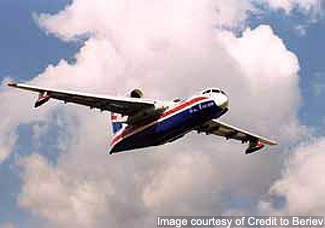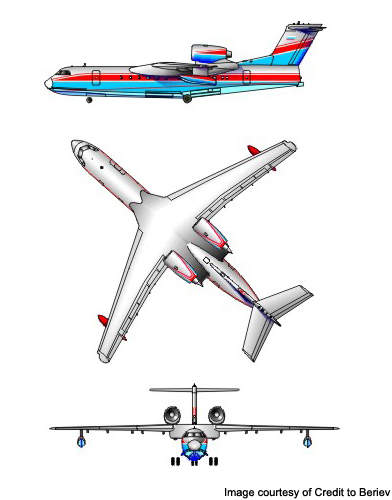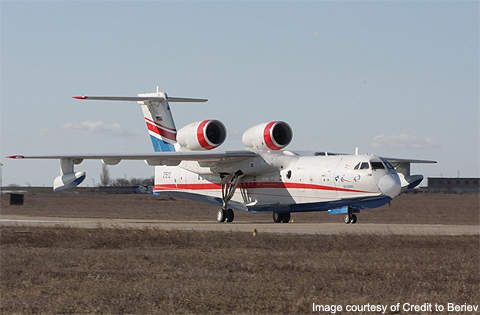The Beriev Be-200 is a multipurpose amphibious aircraft manufactured by Russia-based Irkut. The aircraft was developed under Irkut’s first full-scale civil programme. The Be-200 cooperation programme includes key aviation industry companies such as Beriev Aircraft, Airbus, EADS-Irkut Seaplane (EISP) and EADS.
The Be-200 can be configured for fire fighting, search and rescue, maritime patrol and environmental monitoring, cargo and passenger transportation operations. It can take off and land on unprepared airstrips and water.
The first Be-200 test aircraft completed its maiden flight in September 1998. Be-200ES, the first production aircraft, touched the skies in June 2003. The Russian Ministry of Emergency Situations (Emercom) was the first customer to receive an aircraft in July 2003 under seven Be-200 fire-fighting and rescue aircraft order. The Ministry of Emergencies, Azerbaijan, took the delivery of one Be-200ES aircraft in 2008.
The Russian Navy plans to procure four Be-200 aircraft for reconnaissance and search and rescue duties, with deliveries scheduled between 2010 and 2013. The People’s Liberation Army Navy (PLAN) of China is also in discussions with Russia to buy the maritime search and rescue variant.
Beriev Be-200 amphibious aircraft design
The aircraft was designed by Beriev Aircraft and is assembled at the Irkutsk Aviation Plant of Irkut.
Designed as a multirole amphibious platform, the Be-200 can be configured for a range of missions. The aircraft is a high-wing T-tail monoplane with a single-step design hull. The design provides stability in water.
The airframe is made of aluminium alloys and coated with corrosion-protection materials. The Be-200 features significant maritime characteristics to perform littoral and blue water operations. The aircraft delivers flight characteristics similar to conventional aircraft.
Be-200 mission variants
The Be-200 mission variants include fire-fighting, search and rescue, freighter, passenger aircraft and ambulance. The fire-fighting variant has a crew of two members, and is fitted with fire extinguishing fluid and water tanks. The aircraft can drop 270t of water on the fire area without refuelling.
The search and rescue (SAR) variant can perform operations within an area of 200 miles for 6.5 hours. The aircraft is equipped with an inflatable rubber dinghy, thermal-imaging and optical search aids and first-aid kit. The SAR variant can be configured to carry 45 passengers.
The transport variant is fitted with floor-mounted cargo-handling equipment to transport loose cargoes, as well as cargoes loaded in standard containers and pallets. The aircraft has the capacity to carry 6.5t payload.
The passenger variant, designated as Be-210, can carry 72 passengers. It has the maximum range of 1,850km.
The BE-200 ambulance version can accommodate ten medical staff as well as 30 injured persons on stretchers. The aircraft feature emergency diagnostics and intensive care facilities.
Be-200 cockpit
The Be-200 is equipped with a partial glass cockpit. The cockpit features a digital flight control (fly-by-wire) system and modern navigation systems, including satellite navigation (GPS), flight management system (FMS), autopilot and weather radar.
The flight control system, integrated with an aerodynamic design, provides high manoeuvrability at low speeds as well as better handling capabilities and safety, and reduces the pilot’s workload.
Be-200 avionics suite
The Be-200 integrates a full suite of avionics for all weather requirements. The ARIA 200-M all-weather integrated avionics system features six large LCDs. The system is developed by Honeywell along with the Moscow Research Institute of Aircraft Equipment.
High-bypass ratio engines
The aircraft is powered by two D-346TP high-bypass ratio engines, a TA 12-60 auxiliary power unit, an engine control system and engine vibration monitoring system. The D436TP turbofan engines deliver a higher performance at hot-and-high conditions compared with turboprop engines installed on similar types of fire-fighting aircraft. The engines have been developed with advanced materials and innovative solutions.
Aircraft landing gear
The aircraft is equipped with hydraulically operated rearward retractable landing gear units. Each unit has two wheels in addition to a water rudder, which provides steering in the water. The underwing stabiliser floats fitted on wings provide stability in water.
Be-200 aircraft performance
The Be-200 can fly at a maximum speed of 680km/h. It has a range of 3,300km and service ceiling of 8,000m. The aircraft can climb at a rate of 3,350ft per minute. The Be-200’s maximum take-off weight on the runway and water is 41t and 37.9t respectively.







